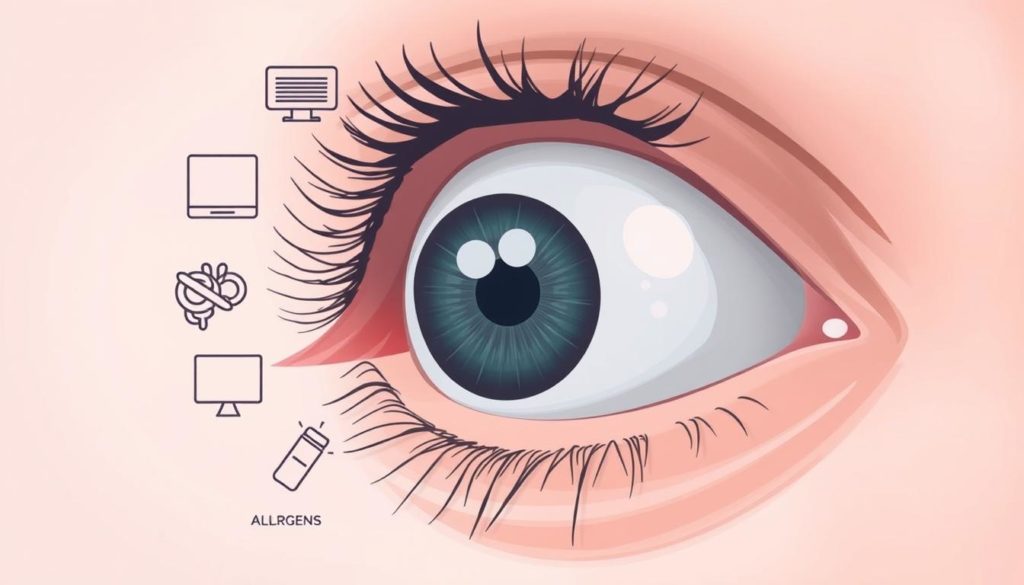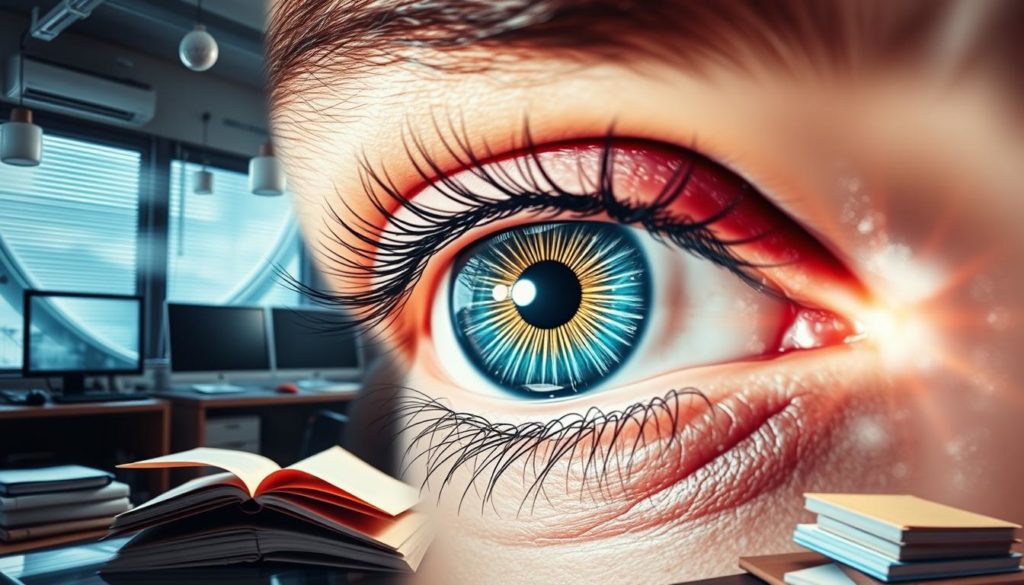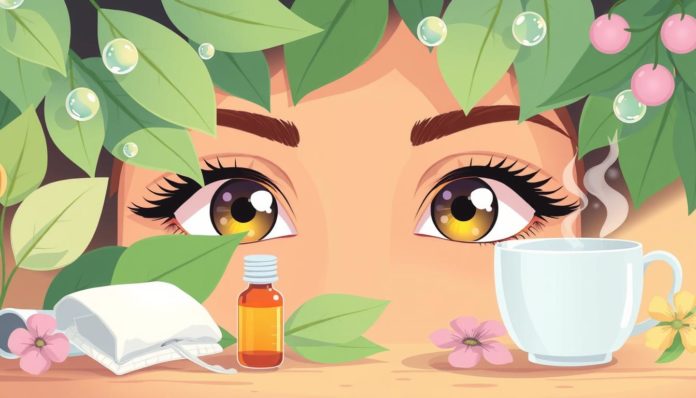Nearly 16 million Americans are affected by dry eye disease. This condition is often not treated. Many people suffer from constant discomfort and blurry vision because of it. My experience in 2011 is a telling example. Poor hygiene with my contact lenses caused corneal abrasions. It made me stop using contacts for a year. Dry eye is a major problem that greatly affects everyday life.
Vatinee Bunya, MD, from the University of Pennsylvania points out that symptoms can vary. They range from feeling something gritty in your eyes to not seeing clearly. There are many ways to get relief from dry eyes. These include using the best eye drops, taking prescription medicines, or trying home remedies. You can find different methods to make your eyes feel better and more comfortable.
This article will cover efficient ways to ease dry eyes. We will look at what habits to avoid and how to keep your eyes moist and healthy for a long time. We’re going to learn about various solutions to fight dry eye disease. Let’s find out how to effectively ease dry eye issues.
Understanding Dry Eyes: Causes and Symptoms
Dry eyes affect millions in the United States. Understanding the causes and symptoms is crucial for finding relief. This condition happens when eyes can’t produce enough good tears. This is often due to aging, genetics, or environmental factors.

Common Causes of Dry Eyes
Many things can cause dry eyes. Wind, smoke, and dry air can make tears evaporate quickly. Some medications, like antihistamines and decongestants, can reduce tear production. Diseases like Sjögren’s syndrome and eyelid problems, like blepharitis, also play a role.
Recognizing the Symptoms
Knowing and treating dry eye symptoms is important. You might feel like you have sand in your eyes, or they might sting or burn. Sometimes, eyes make more tears as a reaction to being dry. Other signs include blurred vision, sensitivity to light, and constant discomfort. Recognizing these can help manage the condition better.
| Dry Eye Causes | Dry Eye Symptoms |
|---|---|
| Aging | Gritty sensation |
| Genetics | Stinging or burning |
| Environmental Factors | Excess tearing |
| Medications | Blurred vision |
| Systemic Diseases | Light sensitivity |
Everyday Habits to Avoid for Dry Eye Relief
Some daily habits can make dry eyes worse. Changing these habits is key to ease dry eyes. Here are important daily changes to help soothe symptoms and tackle dry eye causes.
Reducing Screen Time
Too much screen time is a leading cause of dry eyes. The blue light from devices such as computers, tablets, and smartphones worsens symptoms. Use the 20-20-20 rule to ease your eyes: every 20 minutes, look 20 feet away for 20 seconds.
This simple habit can significantly reduce eye strain and dryness.
Environmental Adjustments
Changing your surroundings is crucial for controlling dry eye causes. Dry air from air conditioners, fans, and heaters may worsen symptoms. Use a humidifier to add moisture to the air. Wearing eye protection in windy settings is also beneficial.

Importance of Hydration in Managing Dry Eyes
Keeping hydrated is key to managing dry eyes. Drinking enough fluids and eating right can really help. Let’s explore how.
Fluids and Diet
Drinking plenty of water is essential. Eating foods high in antioxidants like lutein and vitamin A helps too. Juices from fruits and veggies keep your eyes moist.
Foods with Omega-3 fatty acids, like salmon and walnuts, are also great. They provide natural relief for dry eyes.
Role of Omega-3 Fatty Acids
Omega-3 fatty acids cut down inflammation and help your eye glands work better. This means better eye lubrication. Foods like fish oils, flaxseeds, and chia seeds are good sources.
Adding these to your meals helps your eyes and your overall health. A diet rich in Omega-3s makes a big difference.
| Food Source | Key Nutrient | Benefit |
|---|---|---|
| Salmon | Omega-3 Fatty Acids | Reduces inflammation, eye lubrication |
| Carrots | Vitamin A | Supports eye health |
| Spinach | Lutein | Protects against eye damage |
| Walnuts | Omega-3 Fatty Acids | Improves tear production |
Effective Over-the-Counter Solutions
Finding the right over-the-counter relief for dry eyes is key. Many opt for preservative-free eye drops and gels. These products quickly ease the symptoms.
Choosing the Right Eye Drops
It’s important to choose the right eye drops for relief. Preservative-free eye drops are favored by many. They lessen irritation and allergies. Products like TheraTears and Refresh offer many preservative-free options. They help with various dry eye symptoms.
Benefits of Eye Gels
Eye gels are an effective choice for over-the-counter relief. They are thicker than eye drops, staying on the eye longer. This makes them great for night use or when you need moisture for a long time. Brands like GenTeal and Systane have various gel types. They provide lasting comfort and moisture.
| Product Type | Examples | Benefits |
|---|---|---|
| Preservative-Free Eye Drops | TheraTears, Refresh | Reduce irritation, mimic natural tears |
| Eye Gels | GenTeal, Systane | Long-lasting lubrication, ideal for night use |
Home Remedies for Dry Eyes
Tackling dry eyes can be straightforward with effective home remedies. Implementing the right methods daily can provide significant relief and enhance comfort.
Applying Warm Compresses
One effective home remedy for dry eyes is using a warm compress for eyes. The heat helps to release the oils in the eye’s glands. This improves tear quality.
Simply soak a clean cloth in warm water. Wring out the excess, and lay it over your closed eyes for 5-10 minutes.
Using a Humidifier
A humidifier adds moisture to the air. This is helpful if you’re often in dry or air-conditioned environments. It can prevent your eyes from drying out.
This makes it a simple yet effective solution among home remedies for dry eyes.
Cleaning Eyelids and Lashes
Regular eyelid and lash cleaning can unblock oil glands. It removes potential irritants too. Use a mild cleanser or baby shampoo for this.
Gently scrub your eyelids with a clean cloth. This step is excellent for hygiene and is one of the effective home remedies for dry eyes.
| Home Remedy | Benefits |
|---|---|
| Warm Compress for Eyes | Releases oils in glands, improves tear quality |
| Humidifier | Increases air moisture, prevents eye dryness |
| Cleaning Eyelids and Lashes | Unblocks oil glands, removes irritants |
Tips for Dry Eye Relief with Natural Methods
Finding natural dry eye relief can be easy and effective. First, protect your eyes with sunglasses outdoors. This reduces strain that causes dryness.
Avoiding alcohol is another key step. Alcohol can dry out your body. Instead, drink lots of water daily to stay hydrated.
Blinking exercises are helpful for natural dry eye relief. Blink often when you’re on the computer to keep eyes moist. Getting enough sleep is also important. It helps your eyes rest and stay moist.
Keep your contact lenses clean. Follow the manufacturer’s guidelines for replacing them. This helps prevent dryness and discomfort.
For more tips, visit dry eye natural remedies. Taking a holistic approach improves eye care.
- Wear protective sunglasses to shield eyes from wind.
- Reduce alcohol consumption to prevent dehydration.
- Stay hydrated to keep moisture levels in check.
- Practice blinking exercises regularly, especially when using digital devices.
- Ensure good contact lens hygiene to maintain eye health.
Long-term Solutions and Treatments
If you’re struggling with ongoing dry eye symptoms, looking into lasting solutions is beneficial. Talking to an eye specialist is key for a proper treatment plan. Prescription eye drops and punctal plugs are two main options to consider.
Prescription Eye Drops
Prescription eye drops focus on treating persistent dryness and swelling. They work to boost tear production and enhance the health of the eye surface. Before you begin using them, it’s vital to see an eye care professional. This ensures you get the right drops for your specific situation.
Punctal Plugs
Punctal plugs are great for managing dry eyes over the long haul. These small devices get placed in the tear ducts to keep moisture in and stop tears from draining away. If other treatments haven’t worked for you, this could be an effective choice. It’s a good idea to talk it over with your ophthalmologist to see if it’s right for you.
| Solution | Pros | Cons |
|---|---|---|
| Prescription Eye Drops | Targets inflammation, enhances tear production | Requires regular use, potential side effects |
| Punctal Plugs | Effective moisture retention, minimally invasive | Initial discomfort, potential for infection |
When to See a Doctor
Knowing when to see a doctor for dry eye symptoms is crucial. If you often feel discomfort or have vision troubles, it might signal something serious. Look out for these important signs.
Signs You Need Professional Help
Do you have severe dryness or redness in your eyes? Or feel like something is in your eye? These could be reasons to get medical advice. Blurry vision that doesn’t get better with blinking, and treatments that don’t work, are also red flags. Spotting these signs you need professional help can get you a correct diagnosis and the right treatment.
Possible Underlying Conditions
Long-lasting dry eyes might mean you have an autoimmune disorder called Sjögren’s syndrome. It mainly attacks your moisture-producing glands causing serious dryness. If you think you might have Sjögren’s syndrome, seeing a specialist is a smart move to handle your symptoms better.
| Symptom | Possible Condition |
|---|---|
| Persistent dry eyes | Sjögren’s syndrome |
| Redness and inflammation | Blepharitis |
| Blurred vision | Meibomian gland dysfunction |
Preventive Measures for Dry Eyes
Implementing effective preventive measures for dry eyes can significantly enhance eye comfort and health. Here are some practical strategies to keep in mind.
Adopting proper everyday habits is crucial when considering how to prevent dry eyes. Make an effort to blink frequently, especially during tasks that require prolonged focus, such as reading or working on a computer. This simple action helps distribute moisture evenly across the eye surface.
Environmental factors also play a vital role. Use a humidifier to maintain optimal humidity levels in your living and working spaces. Shield your eyes from harsh elements such as wind and sunlight by wearing protective eyewear.
Staying hydrated is necessary for eye health. Drink plenty of water every day. Also, eat foods rich in omega-3 fatty acids. These nutrients help keep your eyes healthy and prevent dryness.
Avoiding certain environments is also crucial. Limit exposure to air conditioning drafts, smoke, and direct ventilation. Following these simple steps and preventive measures for dry eyes can help manage and reduce dry eye symptoms, giving you lasting comfort.
The Holistic Approach to Managing Dry Eyes
To manage dry eyes holistically, look at your lifestyle and surroundings. Using a good humidifier, cutting down on screen time, and blinking more can make a big difference. These changes can ease your eye strain and make your space more comfortable.
Eating right is key for fighting dry eyes. Add foods like flaxseeds, walnuts, and salmon to your diet. They’re full of Omega-3s which are great for your eyes. Drink lots of water and eat a balanced diet to keep your eyes moist and healthy.
Sticking to a care routine is important too. Use treatments recommended by your eye doctor, both over-the-counter and prescription. Regular check-ups help tailor your care, stopping symptoms from getting worse. Handling dry eyes this way considers all aspects of the condition, leading to the best results.
FAQ
What are some tips for dry eye relief?
To find relief from dry eyes, try cutting down your screen time. Use artificial tears without preservatives. Wear sunglasses for wind protection and keep your contact lenses clean.
What are the best eye drops for dry eyes?
The top picks for dry eyes are artificial tears without preservatives and drops that fight inflammation to boost tear production. It’s best to talk to an eye specialist for advice that fits you.
What causes dry eyes?
Lots of things can cause dry eyes. These include not making enough tears, tears that aren’t high quality, getting older, your genes, and environmental influences. Certain medicines and illnesses like Sjögren’s syndrome play a role too.
Hormonal changes, especially during menopause, can also lead to dry eyes.
How can I recognize the symptoms of dry eyes?
Dry eye symptoms feature a gritty sensation, pain, blurry vision, and the feeling of having something in your eye. Oddly, your eyes might also water more than usual.
How does reducing screen time help relieve dry eyes?
Cutting back on screen time eases dry eyes by lessening eye strain. It also helps you blink more often, which is key for making enough tears.
How do environmental factors affect dry eyes?
Air conditioners, fans, and dry climates worsen dry eyes. Making small changes, like using a humidifier, can help ease the discomfort.
Why is hydration important for managing dry eyes?
Staying hydrated keeps the tear film and eye moisture levels healthy. Drink lots of water and eat foods high in Omega-3 fats for better eye health.
What are some effective over-the-counter solutions for dry eyes?
Looking for quick fixes? Try artificial tears without preservatives, eye gels, and anti-inflammatory drops. These can soothe your eyes right away and support their health over time.
What are some home remedies for dry eyes?
For home treatments, try warm compresses to kickstart tear production. Increase air humidity with a humidifier. Keeping your eyelids and lashes clean helps clear blocked oil glands.
Are there any natural methods for dry eye relief?
Yes, for natural relief shield your eyes from the wind and cut down on drinks that dehydrate you. Getting enough sleep, doing blinking exercises, staying hydrated, and properly maintaining your contact lenses can also help.
What are long-term solutions for chronic dry eyes?
For chronic issues, consider prescription drops and punctal plugs. Discuss these options with your eye doctor for advice that’s right for you.
When should I see a doctor for dry eyes?
If your dry eye issue doesn’t get better or worsens, see a doctor. It could signify a more serious problem like Sjögren’s syndrome. A medical check-up can help manage your symptoms effectively.
What are some preventive measures for dry eyes?
To prevent dry eyes, avoid environments that dry them out. Make lifestyle changes that benefit your eyes, like reducing screen time and staying hydrated.
What does a holistic approach to managing dry eyes involve?
A holistic approach takes your whole life into account: your environment, diet, and the treatments you use. Stay in regular touch with an eye care professional for ongoing advice.


